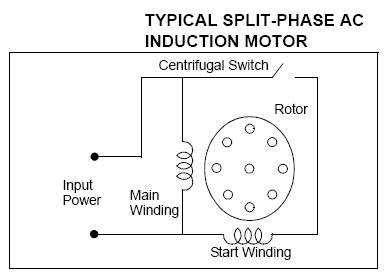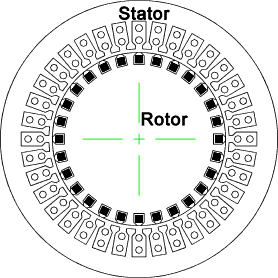Q1: Where
do we require single-phase induction motors?
Ans:
Single-phase induction motors are required where
(i) 3 phase
supply is not available
(ii) efficiency is of lesser importance
(iii) Rating
is less than one H.P.
(iv) Equipment is portable
Q2:
Why is the power factor of a single-phase induction motor low?
Ans:
It is due to the large magnetizing current which ranges from 60% to 70% of
full-load current. As a result, even at no-load, these motors reach
temperatures close to the full-load temperature.
Q3:
What is the function of centrifugal starting switch in a single-phase induction
motor?
Ans:
The centrifugal switch is connected in series with the starting winding. The
primary function of the centrifugal switch is to produce rotating flux in
conjunction with main winding at the time of starting. When the motor has
started and reaches nearly 75% of synchronous speed, it produces its own
rotating field from the cross field effect. The starting winding now has no
function to perform and is removed from the circuit by a centrifugally operated
switch.
Q4:
What happens when the centrifugal starting switch fails to open?
Ans:
If the starting switch fails to open when needed, then the starting winding
will overheat and burn out and motor will not start next time.
Q5:
What happens when the centrifugal switch fails to close when needed?
Ans:
If the centrifugal starting switch fails to close, the motor will overheat the
main winding without any failure of the main winding.
Q6:
Why are resistance split-phase inductions motors most popular?
Ans:
These motors are most popular due to their low cost. They are used where
moderate starting torque is required and where the starting periods are not
frequent. They drive fans, pumps, washing machines, small machine tools etc.
They have power ranting between 60 watts and 250 watts.
Q7:
What is the draw back of the resistance split-phase induction motor?
Ans:
The starting winding has a relatively small number of turns of fine wire and
its resistance is higher than that of the main winding. Therefore the current
density is high and the winding heats up quickly. If the starting period lasts
for more than 5 seconds, the winding begins to smoke and may burn out unless
the motor is protected by a built-in-thermal relay.
Q8:
Why is the starting torque of a resistance split-phase induction motor not
high?
Ans:
The starting torque is given as, Ts = K Im Is Sin Ф
Where
K = constant whose magnitude depends
upon the design of the motor
(i)
The angle between Is and Im is small (approximately 25 degree) in a resistance
split-phase induction motor, so the starting torque is small.
(ii)
Since currents Is and Im are not equal in magnitude, the rotating magnetic
field is not uniform and the starting torque produced is small.
Q9:
Why is the starting torque of a capacitor start induction motor high?
Ans:
The capacitor C in the starting winding is so chosen that Is leads Im by 75
degree. Since the starting torque is directly proportional to Sin Ф, and it is
quite high in capacitor-start induction motor.
Q10:
Why do we use capacitor-start induction motors in applications requiring high
starting torque in preference to repulsion induction motors?
Ans:
Capacitors are easily available, cheaper and reliable. Repulsion-induction
motors posses a special commutator and brushes that require maintenance. Most
manufacturers have stopped making them.
Q11:
What is the principle of operation of shaded-pole induction motor?
Ans:
A shaded-pole motor is basically a small single-phase squirrel cage motor in
which the starting winding is composed of short-circuited copper ring (called
shading coil) surrounding one-third of each pole. The effect of the shading
coil is to cause a flux to sweep across the pole faces, from unshaded to shaded
portion of the pole, producing a weak rotating magnetic field. As a result, the
rotor is set in motion due to induction principle.
Q12:
Which type of torque is developed in single phase motors?
Ans:
Pulsating torque is produced.
Q13:
If a single phase motor is driven in any direction by any means, it starts
running in that direction. Explain why?
Ans:
Actually a pulsating torque has two components which are equal in magnitude and
rotate in opposite direction with synchronous speed at unity slip. Now if the
motor rotates in any direction, the slip decreases and the torque component in
this direction increases than the other component and hence motor runs in that
direction.
Q14:
What is a fractional H.P. motor?
Ans:
A small motor having H.P. less than unit is called fractional H.P. motor.
Q15:
Which type of rotor is used in single phase motors?
Ans:
Squirrel cage type
Q16:
How the starting winding produce rotation in a single phase resistance start
induction motor?
Ans:
The starting winding is highly resistive and the main winding is inductive. So
the phase difference between the two currents becomes nearly 90 degree and
hence the motor start as two phase motor.
Q17:
How the starting winding is made resistive?
Ans:
It consists of only few turns of smaller diameter.
Q18:
How the speed of rotation of a split phase induction motor is reversed?
Ans:
The terminal connections of the starting windings are reversed with respect to
main running windings.
Q19:
What will happen if the centrifugal switch fails to open the starting winding?
Ans:
Excessive heat will be produced due to high resistance of the starting winding due
to which stator temperature will rise and eventually both windings will burn.
Q20:
How speed control is made in single phase motors?
Ans:
It is usually controlled by applying a variable voltage from tapped
transformers, variacs, potentio meters, and tapped reactors.
Q21:
Is there any relation between the capacitances of two capacitors used in two
value capacitor motor?
Ans:
Starting capacitor has about 10 – 15 times high capacity than the value of
running capacitor.
Q22: What is size of shaded-pole motor?
Ans:
These are usually built in small fractional H.P, not exceed 1/4 H.P.
Q23:
Why shaded-pole single phase induction motor does not need any special starting technique like capacitors
and auxiliary winding etc.
Ans:
Because it is inherently self started motor. The construction of the poles is
such that they give a sweep to the magnetic flux and motor starts rotating.
Q24:
How can a universal motor be reversed?
Ans:
By reversing either the field leads or armature leads but not both.
Q25:
What are applications of Stepper motors?
Ans:
(i) Paper feed motors in typewriters and printers
(ii) Positioning of print heads
(iii) Pens in XY-plotters
(iv) Recording heads in computer disc drives etc.
(ii) Positioning of print heads
(iii) Pens in XY-plotters
(iv) Recording heads in computer disc drives etc.
Q26:
Why do we use capacitor-start induction motors in applications requiring high
starting torque in preference to repulsion induction motors?
Ans:
Capacitors are easily available, cheaper and reliable. Repulsion-induction
motors posses a special commutator and brushes that require maintenance. Most
manufacturers have stopped making them.
Q27:
If a single phase motor is driven in any direction by any means, it starts
running in that direction. Explain why?
Ans:
Actually a pulsating torque has two components which are equal in magnitude and
rotate in opposite direction with synchronous speed at unity slip. Now if the
motor rotates in any direction, the slip decreases and the torque component in
this direction increases than the other component and hence motor runs in that
direction.
Q28:
What is a fractional H.P. motor?
Ans:
A small motor having H.P. less than unit is called fractional H.P. motor.
Q29:
Which type of rotor is used in single phase motors?
Ans:
Squirrel cage type
Q30:
How the starting winding produce rotation in a single phase resistance start
induction motor?
Ans:
The starting winding is highly resistive and the main winding is inductive. So
the phase difference between the two currents becomes nearly 90 degree and
hence the motor start as two phase motor.
Q31:
How the starting winding is made resistive?
Ans:
It consists of only few turns of smaller diameter.
Q32:
How the speed of rotation of a split phase induction motor is reversed?
Ans:
The terminal connections of the starting windings are reversed with respect to
main running windings.
















